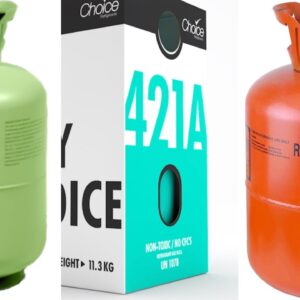In this blog post, the characteristics of three R22 replacement refrigerants – R422D, R407C, and R421A – will be explored and compared. He or she will discover the similarities and differences between these refrigerants, which will be helpful in determining the best replacement option for R22 in various applications. The post will delve into the thermodynamic properties, environmental impact, and performance of each refrigerant to provide a comprehensive comparison. By the end of this article, they will have a better understanding of which refrigerant better suits their needs.
Exploring the Characteristics of R422D, R407C, and R421A: A Comparative Study of R22 Replacement Refrigerants
Introduction
HVAC technicians and tradespeople know that the industry is always evolving. New technologies and techniques are constantly being developed, which can make it hard to keep up. HVAC Shop Talk is a YouTube channel and podcast dedicated to celebrating and educating skilled tradespeople in HVAC. One of their recent videos explored the use of R22 replacement refrigerants, specifically R422D, R407C, and R421A. This comparative study sheds light on the characteristics of these refrigerants and how they can be used as an alternative to the phased-out R22.
The Characteristics of R422D, R407C, and R421A
The presenter of the video starts by explaining that R22 is not being manufactured anymore, and therefore, the industry has to find new refrigerants to replace it. Three possible replacements are R422D, R407C, and R421A. The presenter discusses the properties of each refrigerant and their suitability for different types of HVAC systems. Here is a breakdown of each refrigerant:
R422D
R422D is a blend refrigerant that is designed to be a drop-in replacement for R22 systems. It is an ozone-safe refrigerant with lower global warming potential (GWP) and is ideal for retrofitting R22 systems without requiring equipment changes. However, the presenter cautions that it may not be as efficient as R22 and could lead to higher operating costs.
R407C
R407C is a blend refrigerant that is also meant to be a drop-in replacement for R22 systems. It is another ozone-safe refrigerant with lower GWP and has comparable cooling efficiency to R22. The presenter explains that R407C is an excellent option for retrofitting R22 systems and for systems that require low-temperature refrigeration.
R421A
R421A is a non-azeotropic refrigerant that is designed to be a retrofit for R22, R407A, R407C, and R422D systems. It has zero ozone depletion potential and a lower GWP than R22. The presenter suggests that R421A is an excellent choice for retrofitting refrigeration and air conditioning systems that require low-temperature refrigerants.
Comparison of R422D, R407C, and R421A
After explaining the properties of each refrigerant, the presenter goes on to compare the three refrigerants. He describes their cooling capacity, how easy they are to install, and how much they cost. Here is a summary of the comparison:
Cooling Capacity
- R422D has a lower cooling capacity than R22, which can lead to higher operating costs.
- R407C has comparable cooling capacity to R22 and is a good replacement option for retrofitting R22 systems.
- R421A has a higher cooling capacity than R22 and is suitable for retrofitting refrigeration and air conditioning systems.
Installation
- R422D and R407C are designed to be drop-in replacements for R22, which means that they are easy to install.
- R421A requires some modifications to the system, but it offers excellent energy efficiency, which can lead to long-term cost savings.
Cost
- R422D is the most expensive of the three replacement refrigerants.
- R407C is less expensive than R422D, but more expensive than R421A.
- R421A is the least expensive of the three refrigerants.
Conclusion
In conclusion, R422D, R407C, and R421A are all suitable replacements for R22 systems. However, each refrigerant has unique characteristics that make it more or less suitable for specific systems. R422D and R407C are easy to install, but may have higher operating costs than R22. R421A requires modifications to the system, but offers excellent energy efficiency and is the least expensive of the three refrigerants. HVAC Shop Talk’s video offers a comprehensive guide to understanding the properties and advantages of each refrigerant, making it easier for tradespeople to choose the best option for their systems.
FAQs
-
What is the purpose of replacing R22 refrigerant?
Replacing R22 refrigerant is necessary because it has been phased out due to environmental concerns. The Montreal Protocol was an international agreement to phase out ozone-depleting substances like R22, which was found to contribute to the depletion of the ozone layer. -
Can R422D replace R22 refrigerant without modifications?
Yes, R422D is designed to be a drop-in replacement for R22 systems, which means that it can be used without requiring equipment changes or modifications. -
Is R407C more expensive than R22?
Yes, R407C is more expensive than R22, but it is also an excellent replacement option for retrofitting R22 systems. -
What is a non-azeotropic refrigerant?
A non-azeotropic refrigerant is a blend refrigerant that does not behave like a single-component refrigerant. Instead, it behaves like a mixture of refrigerants, each with a different boiling point. This allows for improved performance in certain applications. -
What is the difference between GWP and ozone depletion potential?
GWP, or global warming potential, measures how much a substance contributes to global warming over time. Ozone depletion potential measures how much a substance contributes to the depletion of the ozone layer.

